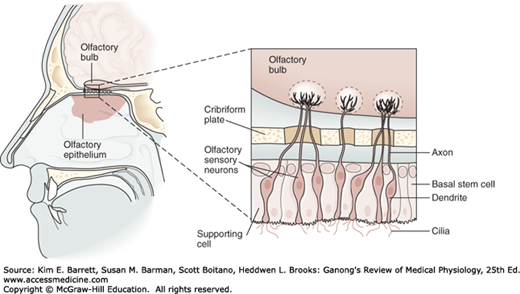Once detected by sensory organs nerve signals are sent to the brain where the signals are processed. Describe the cellular makeup and arrangement of a taste bud.

Structure Of The Olfactory Epithelium And The Underlying Lamina Download Scientific Diagram
Olfactory sensory neurons supporting sustentacular cells and basal stem cells at the base of the epithelium.
. Describe the basic features of the neural elements in the olfactory epithelium and olfactory bulb. Olfactory epithelium is made up of olfactory epithelium and 10 million olfactory neurons. Olfactory nerve fibers extend from the olfactory bulbs and into bi-layered olfactory epithelium that covers the base of the cribriform plate.
The specialized receptor cells in the olfactory epithelium are surrounded by. Describe the location and cellular composition of the olfactory epithelium REVIEW 2. See full answer below.
Outline the pathway by which impulses generated in the olfactory epithelium reach the olfactory cortex. NAME 20 LAB TIMEDATE EXERCISE Special Senses. The olfactory bulb is located at the base of the forebrain in olfactory sulcus.
The transduction of olfactory information occurs in the olfactory epithelium the sheet of neurons and supporting cells that lines approximately half of the nasal cavities. In the nasal cavity it is present on each side of nasal sep. How and why does sniffing increase your ability to detect an odor.
View the full answer. Updated on August 17 2021. Describe the location and cellular composition of taste buds.
It surrounded medially by the gyrus rectus and laterally by the orbital gyri. The olfactory epithelium is a specialized epithelial tissue inside the nasal cavity that is involved in smell. The olfactory receptors also called olfactory sensory neurons are surrounded by the supporting epithelial cells of the olfactory epithelium.
Structure of the olfactory epithelium. Describe the location and cellular composition of the olfactory epithelium. Describe the cellular composition and the location of the olfactory epithelium.
2401 Marieb AP Lab Manual - 10th Edition EXERCISE 26 OLFACTION AND. Histologically it is divided into five layers. The olfactory epithelium occupies an area of about 5 cm2 in the roof of the nasal cavity.
NAME 20 LAB TIMEDATE EXERCISE Special Senses. The olfactory epithelium is the part of the olfactory system directly responsible for detecting odors. Describe the location and cellular composition of the olfactory epithelium.
Describe the location and cellular composition of the olfactory epithelium. Use a diagram if helpful Localization and Anatomy of the Olfactory Receptors. Taste Buds and Taste 3.
The olfactory epithelium includes several types of cells. Step-By-Step Solution Chapter 26 Problem Location_and_Anatomy_of_the_Olfactory_Receptors 9. In humans it measures 9 cm2 and lies on the roof of the nasal cavity about 7 cm above and behind the nostrils.
The specialized receptor cells in the olfactory epithelium are surrounded by supporting cells non-sensory. Olfactory bulb is a bulb-shaped nervous tissue made up of multiple layers of cells. Chemicals in inhaled air are in a gaseous state and must dissolve in the mucus.
In roof of nasal cavity. View 3A P Taste and Olfaction 2012111doc from SCI 2401 at Richland Community College. The olfactory epithelium is located in the nasal cavity on each side of the nasal septum.
Olfactory epithelium is located in the nasal cavity. The olfactory epithelium occupies an area of about 5 cm2 in the roof of the nasal cavity. Describe the location and cellular composition of the olfactory epithelium.
The olfactory system is responsible for our sense of smell. Describe the location and cellular composition of. This sense also known as olfaction is one of our five main senses and involves the detection and identification of molecules in the air.
A one-inch square area on foot of nasal cavity on each side of nasal septum receptors cells. It is continuous posteriorly with the olfactory tract. Olfaction and Taste SHEET Olfactory Epithelium and Olfaction 1.
How and why does sniffing improve your sense of smell. Describe the location and cellular composition of the olfactory epithelium. AREA OF ABOUT 5 cm2 IN ROOF OF NASAL CAVITY.
The distal ends of the olfactory receptors are covered with cilia that project into the nasal cavity where they can contact airborne molecules. Each olfactory sensory neuron has a dendrite that projects to the epithelial surface. Describe the location and cellular composition of the olfactory epithelium.
The remaining surface is lined by respiratory epithelium which lacks neurons and serves primarily as a protective surface The olfactory epithelium includes several distinct cell types Figure 155A. Olfaction and Taste SHEET Olfactory Epithelium and Olfaction 1. CELLULAR COMPOSITION OF OLFACTORY EPITHELIUM IS MADE UP OF APPROXIMATELY 10 MILLION OLFACTORY NEURONS AND AXONS OF THESE BIPOLAR NEURONS.
There are three cell types. Numerous cilia protrude into the mucus layer lining the nasal lumen.


0 Comments